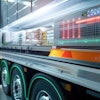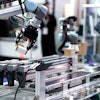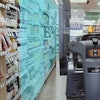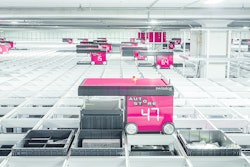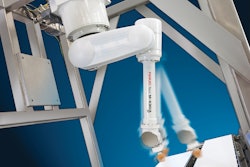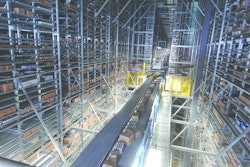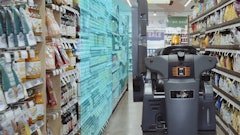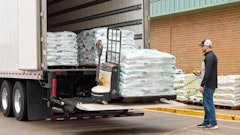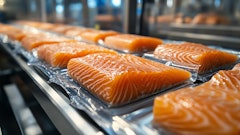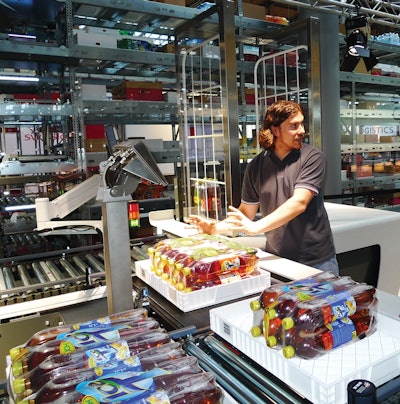
Recently, we asked nearly a dozen of the world’s leading experts on warehouse automation a handful of questions to help us gauge the year ahead and pinpoint specifics for the food and beverage sector.
This is what we wanted to know:
Question #1: The warehouse automation segment, in general, has been performing well over the past few years. What’s the outlook for 2014 and what are some of the factors shaping warehouse automation in the coming year?
Question #2: On the topic of warehouse automation as it pertains specifically to the food/beverage sector, what are some of the unique challenges for clients in this space and how does your company tailor solutions and respond to demands in this sector?
Question #3: Europe has traditionally outpaced the U.S. and other global markets in their adoption and utilization of warehouse automation. Is this still the case? How does the U.S. market compare to other global markets?
Question #4: Are there any “major developments” that are likely to occur in warehouse automation this year, or will the segment continue to make incremental advances when it comes to innovations?
Following are their replies, which you will no doubt find as insightful as we did. – Lara Sowinski, Editor-in-Chief
Dematic’s Mike Kotecki, Senior Vice President, North America
What are you seeing for the year ahead? The food and beverage supply chain, from manufacturing to consumer, differs from others like hard goods, pharmaceutical and automotive in that the opportunity for offshoring the manufacturing component is limited. Thus, the outlook for 2014 in Food and Beverage (F&B) continues to be both strong and end-to-end from pallet-based production automation to order fulfillment. We see no slowing in this sector, but rather a race to gain strategic market advantage while growth abounds.
Meanwhile, like other sectors of the retail industry, the emergence of e-commerce is greatly impacting the food and beverage vertical. In terms of F&B, e-commerce means grocery home delivery, or at least pickup points for entered orders…like in a kiosk, drive-through or the side door of a retail store. Therefore, grocers have found that they can “lean into” e-commerce by fulfilling orders from stores or existing (modified) DCs before they run out and build a dedicated e-com DC. However, until they have a purpose-build ecom DC, the business case of home delivery is weak. That said, home delivery is clearly not going away and most metropolitan grocers know it is imperative in their future.
What about unique challenges to food/bev and your company’s solutions? Specifically in beverage, the wild growth of SKUS and “creativity” in packaging make distribution and technology a challenge. Highly automated solutions are reserved for the high volume distributors, but productivity solutions such as voice picking, sortation, robotics, directed manual layer picking, etc. are often the answer until case volumes become very large.
Secondly, the labor costs in freezer warehousing continue to be a focus, considering that, based on our market survey, productivity in that environment is 5 to 30 percent lower than in ambient. Thus, we continue to see huge interest in pallet, case and now each storage/picking using freezer AS/RS. The business case for automated freezer pallet storage is particularly wonderful.
In addition, the intensity and labor associated with case and each picking continues to be a challenge, particularly in the slow moving tail of the SKU list. Although it seems counter-intuitive, dedicated automation for slow-moving inventory is a very popular area of focus for our customers. Our high-density, slow-moving inventory modules both reduce labor and free up very large amounts of DC real estate where stacks of dusty pallets would otherwise be the answer.
How does warehouse automation in the U.S. compare to other global markets, such as Europe? Europe is faced with several geographic and infrastructure challenges that are less prominent in the U.S. For example, smaller retail spaces, narrower roads and streets, labor rates, unfavorable termination rules, population distribution, import volumes, and so on. There remains a business case for technology investment in the U.S. and Europe, it is just that the drivers often differ. On both continents however, reducing the cost and unpredictability of humans performing material movement remains a primary objective. As volumes increase and solution costs continue to drop in the U.S., the ROIs are rapidly escalating, causing many companies to adopt automation where the business case may have been borderline three years ago.
What’s the forecast for 2014—“major developments” or incremental advances? Though the number of ‘Holy Cow’ new solution introductions will be few, expect step-function improvements in performance levels and functionality. The strong economy has enabled high R&D spending by industry leaders and new clever applications of core technologies will change the game. Sciences like robotics, AGVs and monorail will take on new jobs in the DC and make better use of the labor force. Additionally, advances in software that applies forward-thinking analytics along with human interface tools like gesture and wearable PCs will greatly optimize labor and present data and advice like never before.
Can you give us a MODEX teaser? The economic recovery has included a very cautious re-hiring in the supply chain…our industry’s take on the “jobless recovery.” In the DC, this means that what labor there is, has to be amazingly efficient, satisfied and accurate. Our focus will be a Picking Palooza aimed directly at maximizing the productivity, job satisfaction and effectiveness of the supply chain employee thanks to very well-placed technology and brilliant software.
Intelligrated’s Jerry Koch, Director, Corporate Marketing & Product Management, and Bob Warwick, Vice President, Southeast Region Sales & Operations, Manufacturing Systems
What are you seeing for the year ahead? Jerry Koch: MHI predicted that 2014 would be an even better year than 2013, and some of the factors shaping warehouse automation in the coming year include increases in the adoption of certain types of technology and automated solutions. The ability for end-users to cost-justify solutions with favorable payback periods continues to drive conversations and the need to look at various scales of automation. The challenge of blending the right amount of automation with the right amount of labor to adopt a solution that best fits their business model.
Notable trends continue to press the adoption of software and equipment automation. The impact of the omni-channel shopper continues to drive changes in the retail warehouse and fulfillment environments, driving operations to be more efficient and responsive while maintaining accuracy and expected customer service levels. Similarly, we see the wholesale and service fulfillment operations adopting technology to address mixed load order fulfillment in order to be more efficient and responsive while maintaining accuracy and expected customer service levels.
What about the unique challenges to food/bev and your company’s solutions? Jerry Koch: Some of the unique challenges for food and beverage clients lie in applying expertise across the supply chain—taking end-of-line manufacturing and marrying that expertise with distribution operations. The “wall” between manufacturing and distribution can be considered tall, but Intelligrated offers a range of solutions to prepare product for movement through the supply chain, as well as software and automation technology for distribution operations. Solutions range from unit and mixed-load fulfillment, to full-case and less-than-full case route-based delivery order fulfillment integrating a range of automation and software technologies. Solutions often require a mix of palletizing, robotics, AS/RS, conveyor and sortation, and voice picking technologies with Warehouse Management and Warehouse Control software.
Bob Warwick: Track and trace initiatives are also extremely important to clients in the food and beverage space, not only because of government-mandated regulations, but also for internal inventory tracking as a supply chain efficiency strategy. Clients are taking advantage of the fact that implementation costs for vision systems have gone down and capabilities have increased. Sometimes, issues can arise in food and beverage with case/product orientation limiting barcode readability. Certain products in particular, such as bottles, have the labels oriented differently and they are not always accessible. Advances in vision systems, such as the ability to scan images on cases instead of barcodes alone, improves data tracking integrity and reliability. Intelligrated’s vision integration capabilities allow our clients to remain on the forefront of these advances.
How does warehouse automation in the U.S. compare to other global markets, such as Europe? Jerry Koch: There are cases when automation is easily justified, though the payback period can be much longer in the U.S. and too long for the financial analyst. Often, a solution can be solved a number of different ways using manual or mechanized approaches as well as highly-automated solutions. The concepts vary greatly and have different capital investment and labor requirements. U.S. labor rates and long-term employment costs are less than what is typical in Europe, and can significantly increase the payback period. In some cases, the cost of land in the U.S. can be challenging when you’re in an urban area. But when you get outside of metropolitan areas, the availability and cost of land is much less than what you would see in European countries.
Bob Warwick: Consolidation of facilities also drives adoption of automation, as customers physically can’t get product out the door fast enough without automating. As businesses consolidate distribution operations, automation can be an effective way to increase operational capacity. Furthermore, in urban centers it is common to have closer-to-consumer distribution points that fulfill full and less-than-full case orders for next-day delivery. In the wine and spirits industry, big wholesalers are located in a single area, but pick for the whole state. Because of that, they will do what they call “country runs” and use a very small cross-docking facility to load local delivery trucks.
Jerry Koch: This same need applies to convenience stores and food service replenishment. Intelligrated offers automation solutions to assist with this, from voice picking, pick-to-light, conveyor, sortation, robotics, and the ability to integrate storage and retrieval systems that can be combined with Intelligrated’s Knighted Warehouse Management and Warehouse Control software. With innovative dynamic process control and route-based delivery features, Knighted software creates efficient and accurate order fulfillment execution solutions. All of these technologies help solve the end users’ business goals, no matter their geographic location.
What’s the forecast for 2014—“major developments” or incremental advances?
Jerry Koch: Further advances and adoptions of the concepts and associated software solutions described above will be ongoing this year. We will see the continued evolution and adoption of automated systems, with customers looking for partnerships and expertise to leverage fulfillment capabilities from end-of-line processing throughout the supply chain. We will continue to see an increase in solutions development activity with customers seeking help in selecting the best level of investment.
Can you give us a MODEX teaser? Jerry Koch: Advancements in software for distributed order management and fulfillment execution. We’ll be showing voice picking solutions, automation and sortation technology revolving around omni-channel and fulfillment execution.
ITW Warehouse Automation’s John Barry, Vice President, Sales & Marketing
What are you seeing for the year ahead? Automation has proven itself in Europe and continues to grow at a strong pace, with the installations that have occurred in the U.S. and the need for automation in Asia the outlook for warehouse automation in 2014 will double and continue to grow in the coming years. The main factors driving the change are cost savings, man power efficiency, and space constraints.
What about unique challenges to food/bev and your company’s solutions? The challenges are more on the case picking side of automation, meeting the reducing of man power versus increased cost—can we meet an ROI that offers total automation or does the design have to offer a scaled down level of automation to meet the costing requirements? The dynamic will be geographic—based on cost of labor, land, building requirements, and delivery range. With AS/RS the main driver is storage and the requirements are specific to storage density and through put rates. With the legacy and experience of over 30 systems built we can offer a tailored solution on the front end, case picking or at the palletizer. The other big challenge, especially with beverage, is the increase in SKU’s and new varying package sizes. With our software and new palletizer techniques, we can offer a hand-stack or automated option.
How does warehouse automation in the U.S. compare to other global markets, such as Europe? Europe’s main focus is still AS/RS and it’s leading the charge in this area due to land restrictions. Where the U.S. is leading the charge is with case picking automation and the blending of the AR/RS storage. For the Food and Beverage industries, Europe and the U.S. are very different when it comes to how they ‘go to market,’ but I do see big growth in the U.S. with AS/RS along with case picking automation. As for Europe, we will see some opportunities for case picking, but the SKU differences are so big between the two regions that the need is much less in Europe.
What’s the forecast for 2014—“major developments” or incremental advances? Developments that our customers are asking more and more about are: ‘How can we get to a totally automated system—including the receiving of full pallets to store and then pick, create a mix pallet load and then automatically load out on an outbound trailer?’ And, doing this all with very limited or no labor. The challenge is Cost.
Can you give us a Modex teaser? We are featuring our AS/RS cart-based system; capable of use in ambient and cold freezer environments.
Knapp AG’s Heimo Robosch, Executive Vice President, Sales
What are you seeing for the year ahead? Knapp enters 2014 with a very solid order backlog, which makes the outlook positive—specifically in the U.S., where last year was a record year for sales. We see the requirement for integrated, high performing, flexible warehouse automation solutions remaining strong. One of the main drivers for this in recent years has certainly been the increased success and rollout of e-commerce and multichannel models throughout all of our main market segments and regions.
What about the unique challenges to food/bev and your company’s solutions? The challenges specific to the food and beverage industry are certainly the increasing number of products in the SKU range partially combined with the already mentioned integration of multiple sales channels. Of course, the “usual” challenges, such as increasing cost pressure and accuracy requirements, remain as valid as they always were.
‘Making complexity simple.’ Driven by this company mission, Knapp provides its customers in the food and beverage environment a range of tailored solutions with different degrees of automation—always focusing on keeping it as simple and manageable for our customers as possible. Many of the Knapp solutions are centered around our world leading OSR shuttle technology, which combines ultimate performance and flexibility within one system.
The OSR shuttle system acts as the core element in our fully automated case picking solutions where we combine automated depalletizing with storage/buffering and then transferred to fully automated palletizing in a shop friendly/aisle compliant process, thus creating a perfect case picking solution. This solution is technically less complex and provides up to three times higher performance than comparable solutions on the market.
In other configurations, our OSR shuttle system supports highly dynamic and ergonomic manual case and piece picking via goods-to-person workstations.
For less automated environments, we promote our KiSoft Vision system, a revolutionary optical guided system, which enhances picking performance and accuracy in a complete intuitive, user friendly way, which requires almost zero training. This is particularly important for customer that use a lot of temporary labor to cover peak periods.
How does warehouse automation in the U.S. compare to other global markets, such as Europe? In Europe, warehouse automation has always been driven by very high labor costs, costs and availability of land in suitable locations, energy costs, as well as increasing legal/ergonomic requirements—and all of these topics have become increasingly important in the U.S. as well over the last couple of years. Therefore, we see a strong growth in the demand of future-oriented warehouse automation in the U.S., specifically in the various food retail areas.
What’s the forecast for 2014—“major developments” or incremental advances? Mainly driven by the fact that the business models of our customers face fast and constant changes and become more and more demanding, the development and innovation cycles become shorter and shorter. We believe all leading suppliers have to adjust to this pace and find the right mix between revolutionary and evolutionary developments.
Knapp is specifically known in the industry for innovation that turns into added value for our customers very quickly. For example, our new fully flexible 3D shuttle, a new generation of shuttle that can change both levels and aisles in a racking system, allowing it to fully adjust the number of required shuttles in a system linear to the growth of performance requirements. This new generation fully complements our existing OSR shuttle family and further increases the flexibility of our systems.
Several developments around KiSoft Vision, our brand name for solutions based around optical recognition systems, support our “zero defect strategy” where we can check and verify almost any process in the warehouse and avoid errors in the first place, rather than correcting them later. KiSoft Vision will also play an important role as traceability standards evolve in the food industry.
With the implementation of a generation of revolutionary robotic picking systems for major customers as well as a number of “evolutionary” developments in our leading OSR shuttle technology we believe we’ve formed the right technology mix for another very interesting year.
Can you give us a MODEX teaser? In Knapp’s Booth #6323 at MODEX, two technologies will be on display, which Food Logistics readers should find very interesting. First, Vision technology using augmented reality will be especially significant as traceability standards continue to evolve in the food industry. Also, Open Shuttle—free-moving vehicles that can be used for transport and picking activities and well-suited for complex transport networks within a warehouse—will be displayed.
Power Automation System’s (PAS) Cory Hypes, Executive Vice President
What are you seeing for the year ahead? The outlook for 2014 for the warehouse automation industry is mostly positive. We see the increase in capital spending continuing due to mostly positive projections from our customers and the need to spend capital to offset additional labor and contain other operating costs. Other operating costs that we see as drivers for automation include space, energy, and transportation.
What about the unique challenges to food/bev and your company’s solutions? The food/beverage industry grows at an average rate of 4.5 percent annually, yet the majority of existing facilities are unable to accommodate the growth of inventory, thus requiring either facility expansion, third-party warehousing or new technologies to maximize the utilization of the existing facility. The PAS solution specifically satisfies the need to maximize the utilization of a company’s existing facility, or to reduce the footprint and operational costs of an expansion.
How does warehouse automation in the U.S. compare to other global markets, such as Europe? Europe is a very mature market when it comes to warehouse automation. The operating costs and space limitation drive automation as a first choice [compared to companies operating in the U.S. and elsewhere]. Globally, we see Asia’s adoption rate of technology greater than that of the U.S., simply due to the pace and scale of their growth, which requires an accelerated view of the impact of automation and the investment.
What’s the forecast for 2014—“major developments” or incremental advances? We see that the major development with regards to warehouse automation is really a shift in the mindset of our customers. After decades of deploying advanced technologies to maximize the effectiveness of the “manufacturing of goods,” companies are beginning to operate and manage the traditional “warehouse” more like a production environment. With automation being the key to harvesting many opportunities in the production of goods, it only makes sense that innovations in warehouse automation be utilized and managed as they are in the production process.
We can see a future where due to automation, raw materials are converted to product, packaged, bottled and/or cased, palletized, then automatically stored and delivered to shipping docks with minimal manual intervention and where every step is electronically controlled, tracked and traceable.
Plant engineers are increasingly becoming more diverse and skilled in mechatronics due to ever advancing technologies, and with so much to gain from leveraging the latest innovation in “automation warehouse” like the PowerStor, we are sure the move will be swift.
Can you give us a MODEX teaser? We, at Power Automation Systems, are very excited about exhibiting at MODEX. We will be demonstrating a fully operational PowerStor automated storage system, as well as our new PASWare 3.0 software suite, which is specially designed for our food and beverage customers. PASWare 3.0 will include all the WMS functionality our customers need and none that they don’t—making it a cost effective transition from the antiquated systems most of our customers have been working with.
Retrotech’s Tom O’Dette, Director of Engineering—Midwest
What are you seeing for the year ahead? The warehouse automation segment is poised to continue to grow in 2014. Three primary factors will fuel the growth:
1. B2B and B2C customers are increasing their order frequency and segmentation, while decreasing the quantity of units. This behavior puts additional stress on the warehouse to fulfill an increased number of orders just to maintain volume. Automation offers a means to relieve this stress within an organization’s existing infrastructure.
2. Transportation costs remain high and variable.Warehouse automation creates supply chain flexibility and visibility to leverage both transportation purchasing and utilization opportunities.
3. Workforce retention and performance are instrumental to delivering world class distribution cost and service. In many cases, automating the warehouse is evidence to employees that management is dedicated to the site and cares about the quality of the work environment. The result is happier employees. Workers that know management will provide the tools to make them successful. Happier workers tend to lead to increased supply chain success, due to the related increases in flexibility and productivity.
What about the unique challenges to food/bev and your company’s solutions? A few of the unique challenges in this space are rainbow pallets, store-ready build, lot control, and cold storage picking environment. Retrotech’s AS/RS expertise with deep lane storage, cooler/freezer picking, goods-to-person order, and build-to-pallet are especially valuable to food and beverage clients.
We have a right-sized solution design mentality, outstanding experience and a unique ability to integrate and modernize a variety of different technologies. Our solutions are supported by strong WCS software. We enable customers to plan, execute, adapt and improve all “within the walls” operations in real time. The result is that management has extremely easy (intuitive) access to both macro and micro real time information on warehouse activity. A comprehensive view enables better decision making and optimized corrective actions for unplanned events.
How does warehouse automation in the U.S. compare to other global markets, such as Europe? Europe is still ahead of the U.S. in warehouse automation. There are two major drivers for that focus in Europe. They have population density that creates real estate issues and are forced to invent creative and innovative ways to utilize vertical space. Europe also has labor issues that are more stringent than the U.S., so they look to automation as a solution.
More and more U.S. customers are looking to automation to optimize their businesses and make a substantial impact on the bottom line. Europe, as well as Asia, continues to influence the adoption of automation in the U.S. market.
A number of factors are feeding automation growth in the U.S.: the population continues to grow; cost of labor; labor turnover; SKU growth; smaller, more frequent orders; same day shipments; fuel cost; etc. These factors are prohibitive to big, greenfield designs with high labor turnover, low ceilings and miles of costly conveyor equipment. Retrotech is in a strong position to leverage the experience of our European operations to deploy automation solutions here in North America. We know the best methods to right size system designs without the capital and physical burden of “remove and replace.” We can take an older, less flexible and under-sized solution that is creating a bottleneck within a warehouse and successfully optimize it to operate with new order profile requirements.
What’s the forecast for 2014—“major developments” or incremental advancements? Two of the biggest warehouse automation advances this year will be the growth of same-day delivery guarantees, as well as the attention and restructure of omni-channels. We’ll be watching to see if the top online and brick and mortar retailers can make it work and if they are successful, how early will others adopt?
Can you give us a MODEX teaser? During MODEX, Retrotech (booth #8717) will be talking to several industries, but specifically to the food and beverage companies about creating more cost effective automated solutions to improve their supply chain by adding or upgrading to their automated material handling equipment/software, while having a minimal impact on operations. Retrotech is seeing an increase in system analytics or data analysis, which can help to streamline any warehouse workflow. For handling food and beverage materials, Retrotech consistently helps organizations increase their efficiency, effectively deal with heavy product loads and put in place comprehensive traceability solutions. We also help organizations address manual labor challenges by adding automated solutions for heavy loads, cold storage and customized pallet loading.
SSI Schaefer’s Ross Halket, Executive Director, ASD Sales
What are you seeing for the year ahead? Due to the influx of the e-commerce market and the decline in available labor, particularly in the split-case each picking arena as well as the automatic case picking arena, the need for warehouse automation will continue to increasingly grow in 2014. We are expecting to partner with more clients than ever this year to meet the demand for warehouse automation in 2014.
What about the unique challenges to food/bev and your company’s solutions? In the food and beverage markets, we also see an issue with the available labor force. It is indeed very hard to find employees willing to pick cases on second and third shift schedules.
For those clients that have the high volume to justify the capital outlay, we see a move in the food and beverage markets to picking methodologies that allow every SKU to be equally accessible without creating bottlenecks.
How does warehouse automation in the U.S. compare to other global markets, such as Europe? In my opinion, the European and Asian markets are still leading the way in warehouse automation due to their use of a more detailed ROI calculation. Projects are won and lost not only on labor savings (customary in North America), but also in accuracy gains, additional available throughput and reduction in required building size (footprint). Also, the investment in research and development appears to be higher with European-based automation suppliers.
What’s the forecast for 2014—“major developments” or incremental advances? Although innovation continues, I see a trend to more incremental advances for the next couple of years. Then we will see another wave of revolutionary technology releases.
Can you give us a MODEX teaser? At the MODEX booth, attendees will be able to learn more about Schaefer’s role in the evolution of distribution. We will be displaying our vertical lift module (LOGIMAT) and Autocruiser that visitors can try out firsthand. We will also be displaying information about our cutting edge 3D-Matrix Solution that is eliminating bottlenecks in the warehouse and revolutionizing automation.
Swisslog’s Bill Leber, Business Development, Warehouse & Distribution Solutions
What are you seeing for the year ahead? The strong growth we have experienced in this sector of the market is expected to continue into 2014 and beyond. Food (refrigerated & frozen) was the largest market segment for Swisslog in 2013, and we see even better performance in 2014.
Occupancy rates for distribution centers (DCs) in the U.S. continue to rise following the speculative overbuilding, which was done prior to the financial crisis of 2008/2009.
What about the unique challenges to food/bev and your company’s solutions? SKU growth continues to be a major challenge, which continues to drive the needs for expanded DC capabilities. Much of this is due to growth in demand for organic-certified foods, which also requires segregated storage that automation can more efficiently assure. Increased demands for track and trace reporting also drives the attractiveness of automation versus conventional facilities. Our technical offerings have a long standing reputation for meeting these market demands.
For the Food market, quality and assortment availability still trumps costs as the top competitive priority—this is a perfect fit for the performance and efficiency that automation can provide.
How does warehouse automation in the U.S. compare to other global markets, such as Europe? Europe continues to far outpace the U.S. in the penetration (adoption and usage) of automated facilities. This has been driven by higher labor, energy and space (due to location more typically in population centers) costs, and longer investment horizons. All of these factors are also increasing in the U.S. and the gap compared to Europe is closing. Improved economic stability here in the U.S. is slowly moving the focus of major producers toward expansion versus cost containment as their top priority.
What’s the forecast for 2014—“major developments” or incremental advances? No major “breakthrough” developments, but a variety of incremental improvements to proven solutions, especially our Vectura AS/RS cranes, which have been deployed for some time. We see good prospects for our AGVPick solution, which was launched and first deployed into the market in 2013.
Can you give us a MODEX teaser? Yes, we are highlighting our leading market position in refrigerated and frozen AS/RS solutions. Will present some new monitoring service capabilities we have put in place to insure that our customers maintain full system throughput performance on a 24/7 basis. Our tag line for the Food market for the MODEX show will be: “Speed up your Fulfillment process…And Unfreeze your Cold Storage operations.”
Westfalia Technologies’ Dan Labell, President
What are you seeing for the year ahead? The outlook for 2014 continues to be positive for sales growth. General interest in the technology remains high, with more end users embracing the technology. Recent successes in delivering anticipated savings and faster project execution has also helped foster this growth. The market is getting more confident about AS/RS in our opinion, at least as it relates to crane-based AS/RS’s.
What about the unique challenges to food/bev and your company’s solutions? As with most industries serving the demanding consumer, we are seeing that the food and beverage industry is concerned with cutting operational costs while improving customer service levels in effort to stay competitive.
We have developed tools (mostly machines and software) that provide flexibility and redundancy to address these primary concerns of the food and beverage industry. These are 1) Reliability; 2) Flexibility for future SKU, inventory, and volume growth; and 3) Performance (high throughput rates with high utilization levels). Customers want to squeeze as much out of these assets as possible, so the tools employed must address these high level requirements.
How does warehouse automation in the U.S. compare to other global markets, such as Europe? I think it is still well behind from a standpoint of “number of systems built” per annual GDP or other metric that can be used to compare. It is not uncommon to drive through industrial areas in Germany and notice that 50 percent of the warehouses are automated high-rise systems.
Land is a big driver, as are labor costs. But, America is catching up. As transportation costs continue to increase, pressures will remain in trying to build inventories and operate warehouses close to the market, in high population areas. Many plants are just as land-locked in the U.S. as they are in Europe, because they reside close to the population centers.
What’s the forecast for 2014—“major developments” or incremental advances? I believe the advances will be more incremental in nature. There are some innovative ideas that we have developed over the years, but they remain on the back burner due to higher costs and lack of adequate ROI’s. So there is innovation, but getting to a consistent winning product is not easy, similar to most industries.
Can you give us a MODEX teaser? Since ProMat, we have had some notable project starts and completions within the food and beverage industry. We will be showcasing these solutions developed for key industry leaders at our booth as well as showcasing a new benefits calculator we developed to help clients answer common questions related to AS/RS benefits earlier in the planning process.
WITRON’s Karl Hoegen, CEO, North America
What are you seeing for the year ahead? The warehouse automation industry will remain very strong. This year brings with it a strong pipeline of prospective clients in retail and food & beverage manufacturers. This is impacted by the need to expand distribution networks while being cautious about the impact of future labor availability. The idea of completely automating an operation is gaining more traction in the industry simply because systems integrators have proven the reliability—and more importantly—the financial justification.
What about the unique challenges to food/bev and your company’s solutions? The greatest concerns are the unknowns related to government regulations and benefits. As labor and overhead costs continue to rise, and the e-commerce marketplace is growing larger, food and beverage clients need to be more aggressive in their approach to the supply chain. In addition to this, we see SKU growth based on the consumer’s continued appetite for more flavors and more package sizes as a major challenge within the food and beverage sector. This, and the fact that manufacturers continue to optimize packaging in an effort to reduce environmental impact and cost, leads to further challenges in regards to future planning.
Our solutions are designed to offer value upstream and downstream. Clients are no longer looking for the warehouse solution; they need the supply chain solution. Within any automated system, the most important aspect is flexibility to adapt to the future unknowns.
How does warehouse automation in the U.S. compare to other global markets, such as Europe? In the AS/RS industry, most of the new innovations are coming from the other side of the North Atlantic. European companies adopted warehouse automation earlier than their U.S. counterparts because they faced the challenges of high labor cost, high land cost, and environmental and ergonomic legislation much sooner. Even though those challenges are now becoming more prominent here in the U.S., most of the large scale automation system purchases are coming from Europe. European retailers are dedicating their entire supply chain network to fully automated warehouse solutions. We are seeing a very proactive customer base in Europe that is focused not only on the ROI, but also what is strategically appropriate for their company culture and future goals.
Wynright’s Gordon Hellberg, Executive Vice President, Sales
What are you seeing for the year ahead? We expect the demand to remain steady in 2014 as many companies continue to look towards automation for productivity enhancements. Because there is an increasing awareness of the benefits of automating material handling, we are seeing advances that will make these types of systems the compelling choice over human material handling.
The fact that so many advances are happening now bodes well for the automation segment as a whole. More and more medium- to large-size organizations are seeking “sensible automation.” Understandably, not all are ready for “all-in” approaches—but, when the projected productivity improvements offset the capital entry costs, the possibility becomes more real. Targeting certain high return areas seems to be a more comfortable path to get started.
What about the unique challenges to food/bev and your company’s solutions? Customer demands are driving more DSD from some major manufacturers, and that needs support. The demand for store- and aisle-friendly shipments is increasing.Many providers who have been accustomed to picking and shipping case level orders are now considering making investments in infrastructure to support the need for each picking. Technologies are continuing to emerge that allow for automation of both of these picking requirements.
How does warehouse automation in the U.S. compare to other global markets, such as Europe? The U.S. is slowly moving the direction of Europe in terms of using complex automation. In other parts of the world, the drivers that cause companies to adopt “all-in” automation are not prevalent here (although I believe they are incrementally approaching). Some major players in the U.S. market have built highly automated facilities, but few have done so across their entire network. The popularity of “goods-to-person,” which originated in Europe, has now captured attention in the U.S.—so the trend is beginning. A recent successful approach is “goods-to-robot” and even “robot-to-goods.” Combine vision technology with advanced robotics and you see systems that require less infrastructure with lower investment. The focus on the task as opposed to the facilitation of that task is a more sensible approach
What’s the forecast for 2014—“major developments” or incremental advances? Robotics is playing a larger role in the automation of distribution centers. The newest application is in autonomous loading and unloading of trucks and containers at the case level. These systems are getting faster and more robust. The technology has advanced and demand has grown significantly in just the past few years. New vision systems and multi-use handling devices coupled with existing robotic technology have resulted in enormous flexibility, and an increased ability to handle greater volume. Robotic case picking can also be combined with existing technologies like voice or light, to create more efficient interactive solutions. The best part is that these innovations are requiring less overall capital investment and are within reach for many operations.
Can you give us a MODEX teaser? Our parent company, Daifuku Webb, will be showcasing flexible AGV’s at MODEX as well as highlighting our combined strength as a solution provider.


